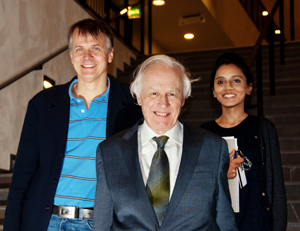Entangled in Experimental Physics
RESEARCH PROFILE
Pakistan-born Saroosh Shabbir came to KTH with a background in theoretical physics, but her PhD work has pulled her into experimentation around the strange behaviour of light and particles in the sub-atomic quantum world. “I like being able to go beyond analysis and produce evidence to prove the theories,” she says.

The baffling phenomenon known as entanglement ranks among the most profound questions of modern quantum physics. Since Albert Einstein famously declared in 1912 that, “the more success the quantum theory has, the sillier it looks,” science has been able to show that entangled objects — atoms, particles or photons — can reach across space and even time to affect one another. It’s also become clear that the very observation of certain characteristics of one object instantly defines the corresponding state of a distant, entangled partner.
Quantum theory violates many of the basic rules of Newtonian physics that govern the macro world we see around us, and it flies in the face of common sense. The theory works, but no one can yet say why.
The term entanglement was coined in 1935, shortly after Einstein and collaborators Boris Podolsky and Nathan Rosen published a thought experiment demonstrating that, when two objects interact in a particular way, quantum physics demands that they must become linked so that measuring a property of one establishes the value of that property for the other — without any passage of time and even if the two are light-years apart.
Decades passed with entanglement theory languishing as an untestable curiosity out on the far reaches of physics, almost more philosophy than real science. It would take until 1982 for the French physicist Alain Aspect, now with the Institut d'Optique École Polytechnique, to envision and construct a complicated experimental set-up for creating entangled atoms by exciting calcium.
Entanglement made easier
Entanglement has been demonstrated over and over in the 30 years since Aspect’s breakthrough work, and has been extended to objects other than atoms, most notably the tiny units of light called photons. Now KTH doctoral candidate Saroosh Shabbir is working on simplifying the tools researchers use to create those entangled photons. Her tabletop system is aimed at making it simpler for physicists to generate the entangled raw material for experimentation.
“Before coming to KTH, all my work in physics had been purely theoretical,” she says. “And when you’re working in theory you tend to be very abstract. You can do thought experiments and analysis, but you don’t know how good the work is from an experimental perspective or even whether it can be implemented. At the end of the day, you want to be able to show evidence proving your theories.”

One might expect that an apparatus built to generate anything as exotic as entangled photons should look like it was dreamed by a special effects team for a sci-fi film, but the device on a counter in Shabbir’s lab is surprisingly simple — and that’s very much the point. From off-the-shelf components, Shabbir and her research team have assembled a laser-light source that beams photons through various optical polarisers, which are essentially filters that allow the light oscillating in certain directions to pass through while blocking other oscillations. Everything here is readily available and inexpensive.
Under the supervision of Professor Gunnar Björk, a photonics specialist in the KTH School of Information and Communication Technology, Shabbir is working on a sort of Swiss Army Knife for quantum physics, a device able to create entanglement in specific, selected properties and involving not just two photons, but four, eight or more. “When you get up to entanglements of eight photons, it gets very difficult to use conventional techniques,” Björk explains. “We’re pushing that limit significantly. Our record so far is a 30-photon entanglement.”
Until recently, the lab had only been able to produce results around a particular quantum state, but just since last November Shabbir has succeeded in tuning the device to generate made-to-order photon entanglement for general quantum states. “You just tell her to make a certain state and she can do it,” Björk says. “I don’t know of any other physicists who are this far along.”
Having earned her undergraduate and Master’s degrees at University College London, Shabbir says her path to a PhD programme at KTH was paved by a persistent, months-long search, and she advises prospective applicants to start the process early.

“Of course, you have to look through published journal articles to find out who is working in the field you’re interested in, but it’s time-consuming to apply to every one. When you’re not accepted, you’re not usually told why, and that can be frustrating. For me, it was a full-time job for about half a year.” But it finally paid off when she got to meet Gunnar Björk and talk about what she could contribute to his research team.
She says Björk inspired her to begin her PhD studies with a shift from theoretical to experimental research. “Gunnar is a strong believer in getting experience on both sides,” she says now. “My intention for now is to make a career in academic research, but if I change my mind and decide to look in the private sector once I’ve finished my degree, this gives me more choices.”
By Kevin Billinghurst | kb2@kth.se

